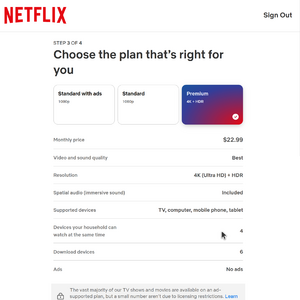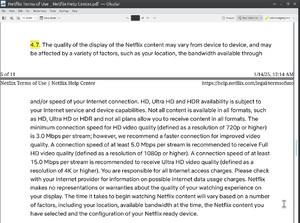Please note that all submissions to the site are subject to the wiki's licence, CC 4.0 BY-SA, as found here
Netflix 4K Stream Quality Controversy: Difference between revisions
Created all of this so far |
No edit summary |
||
| Line 2: | Line 2: | ||
Currently, Netflix offers 1080p video resolution on every plan they offer on their [https://help.netflix.com/en/node/24926 Plans and Pricing] for a subscription. Consumers who watch Netflix on web browsers will be paying for 1080p resolution while only receiving 720p resolution maximum due to DRM. The TOS allows Netflix to claim your device faulty or your internet speed slow to justify this behavior. | Currently, Netflix offers 1080p video resolution on every plan they offer on their [https://help.netflix.com/en/node/24926 Plans and Pricing] for a subscription. Consumers who watch Netflix on web browsers will be paying for 1080p resolution while only receiving 720p resolution maximum due to DRM. The TOS allows Netflix to claim your device faulty or your internet speed slow to justify this behavior. | ||
[[File:Netflix signup page- choosing your plan.png|alt=Signing up for Netflix: top of choosing your plan page|thumb|Signing up for Netflix: top of choosing your plan page]] | |||
[[File:Netflix signup page- choose plan bottom of page.png|alt=Netflix signup page: plan choice, bottom of page.|thumb|Netflix signup page: plan choice, bottom of page. ]] | |||
[[File:Netflix terms of service covering streaming quality.png|alt=Netflix terms of service covering streaming quality|thumb|Netflix terms of service covering streaming quality]] | |||
The only time you see there are any limitations is in incredibly small font, on the bottom of the page where you choose a plan. The 4k HDR option is the default option and has an icon with very appealing colors that draw your eyes to this more expensive option, while you must scroll to the bottom to even be linked to a document that explains the limitations. <ref>https://web.archive.org/web/20250111144808/https://help.netflix.com/legal/termsofuse</ref> The explanation provided on this terms of service that must be dug through, is completely inadequate. See below: | |||
Revision as of 06:40, 14 January 2025
Netflix, in their Terms of Service (TOS), lists reasons why the quality of its content may vary from different devices, as stated in clause 4.7: "The quality of the display of the Netflix content may vary from device to device, and may be affected by a variety of factors, such as your location, the bandwidth available through and/or speed of your Internet connection." One of the factors not listed is the use of Widevine, a Digital Rights Management (DRM) software which is embedded into most web browsers such as Chrome, Chromium, Electron (CEF), Firefox, Edge, Opera, Safari, etc. A DRM protects media hosted on Netflix from being screen-captured, with one of the methods using "SECURE_DECODE", which uses Widevine to decode each frame displayed. This method demands more bandwidth, with Netflix appeasing the disparity by decreasing the quality to 720p on web browsers.
Currently, Netflix offers 1080p video resolution on every plan they offer on their Plans and Pricing for a subscription. Consumers who watch Netflix on web browsers will be paying for 1080p resolution while only receiving 720p resolution maximum due to DRM. The TOS allows Netflix to claim your device faulty or your internet speed slow to justify this behavior.



The only time you see there are any limitations is in incredibly small font, on the bottom of the page where you choose a plan. The 4k HDR option is the default option and has an icon with very appealing colors that draw your eyes to this more expensive option, while you must scroll to the bottom to even be linked to a document that explains the limitations. [1] The explanation provided on this terms of service that must be dug through, is completely inadequate. See below: